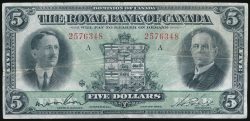Collecting Rare Banknotes from Chartered Banks

Throughout Canada’s history, chartered banks from cities across Canada issued their own currency to their local patrons. These now out-of-business banks created a wide variety of paper banknotes during the 19th and 20th centuries. Chartered banknotes can range in denominations of 20-dollars to thousands of dollars. Trying to find a value for a specific chartered banknote can be challenging due to the variety on the market. It wasn’t uncommon for some banks to have local branches in more than one city, this can make an appraisal difficult. Our team of historical currency experts combine years of experience with some of the best-chartered banknote resources in the industry to offer accurate appraisals.
Like any other banknote, the condition and rarity of the bill will be the major factors in determining a value. The location of the bank that issued the banknote is another important factor. Smaller towns typically had one bank and larger cities had dozens, a bill from a smaller town will typically have more value than one from Toronto or Montreal. Unlike other collectibles, older isn’t always better when it comes to charter banknotes, again, it really comes down to supply and demand.
One of the reasons that chartered banknotes appeal to collectors is their stunning artwork and high-quality production. Some of Canada’s oldest Dominion of Canada are very plain with little in the way of artistic impression. Many of the banks printing paper money took pride in the visual look of their money, and this artwork adds value to bills today. Details such as colour and vignettes on the banknote make the bill extremely valuable and excellent pieces to display.
The serial number on a chartered banknote will add value if is a serial numbered bill. A serial number of over 1 million will typically indicate that a banknote is fairly common. If your bill has a serial number with six digits it can have value, but won’t be extremely rare. A bill with a serial number that’s less than 10,000 has an excellent chance of being rare and can make an excellent addition to any Canadian currency collection.
Most currency collectors prefer to own banknotes that were actually released for circulation. These bills will have serial numbers and signatures on them. On the other hand, specimens will typically not have a serial number or it will simply be a series of zeros. Banks would sometimes have left over and unused bills from their printing process, these banknotes are known as remainders and were not used in circulation. Remainders were considered as waste at the time, but today they can generate value. Bills with a higher denomination will typically get more value than a bill with a lower denomination. A 100-dollar bill is going to be rarer than a two-dollar note.
